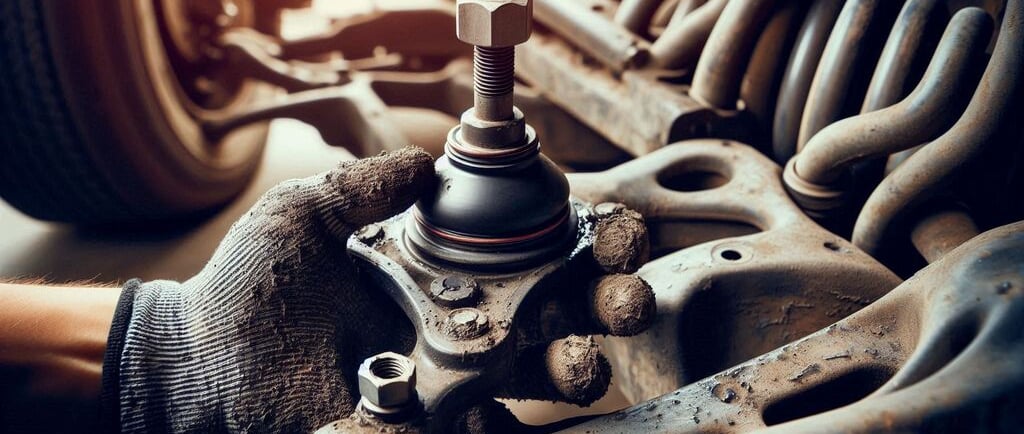Ball Joints
When it comes to keeping your vehicle stable and steering smooth, ball joints are one of the most crucial components.
SUSPENSION PARTS
11/14/20244 min read


Understanding Ball Joints: The Key to a Smooth and Safe Ride
When it comes to keeping your vehicle stable and steering smooth, ball joints are one of the most crucial components. These small but mighty parts are essential for safe handling, preventing tire wear, and providing a comfortable ride. But like many parts in your vehicle’s suspension system, they can wear out over time, impacting performance and safety.
This article will explore what ball joints are, why they’re essential, how to spot signs of wear, and some tips for maintaining them.
What Are Ball Joints?
Ball joints are pivot points between the wheels and suspension in your vehicle. Each ball joint is designed with a ball-and-socket structure, similar to the joints in your shoulder or hip. This structure allows for a wide range of motion, giving your wheels the flexibility to move up and down with the road’s surface while also allowing you to steer left and right.
There are typically two types of ball joints in a car:
Upper Ball Joints: These are often found in vehicles with two ball joints per wheel, helping manage vertical movement.
Lower Ball Joints: Lower ball joints bear more of the vehicle's weight and are thus subject to higher wear, especially in heavier vehicles.
Why Are Ball Joints Important?
Ball joints play a pivotal role in your vehicle’s suspension system. They help ensure:
Smooth Steering: By allowing the wheels to pivot, ball joints make steering smooth and responsive.
Vehicle Stability: They keep the tires properly aligned, ensuring your vehicle remains stable on the road.
Reduced Tire Wear: When ball joints are in good condition, they prevent uneven tire wear by keeping the wheels aligned, which can save you money on tire replacements.
Signs of Worn Ball Joints
Ball joints are designed to last, but wear and tear can take a toll over time, especially in off-road or high-mileage vehicles. Here are some common signs that your ball joints might need attention:
1. Clunking Noises
One of the most noticeable signs of worn ball joints is a clunking noise coming from the suspension area. This sound is often due to the ball joint losing its tight connection, causing it to move around more than it should.
2. Steering Wheel Vibration
If you feel vibration in your steering wheel, especially while driving over rough or uneven surfaces, it may be due to loose ball joints. This can affect control, making it harder to steer accurately.
3. Uneven Tire Wear
Worn ball joints can cause the wheels to misalign, leading to uneven tire wear. You might notice the inner or outer edges of the tire wearing out faster than the rest.
4. Vehicle Pulling to One Side
If your car pulls to one side when driving straight, worn ball joints could be the culprit. This pulling occurs because the ball joints can no longer maintain proper wheel alignment, impacting your vehicle’s handling.
How to Inspect and Test Ball Joints
Ball joints should be inspected regularly, especially if you frequently drive on rough roads or have a high-mileage vehicle. Here’s how to check your ball joints:
Visual Inspection: Look under the vehicle to see if the ball joint boots (the rubber covering) are torn or leaking grease. If they are, dirt and debris may have entered, accelerating wear.
Manual Testing: With the vehicle raised, try to wiggle the wheel up and down or side to side. If you notice any excessive play, it could be due to a worn ball joint.
If you’re not comfortable inspecting ball joints yourself, a qualified mechanic can check them during routine maintenance or alignments.
Maintenance Tips for Ball Joints
Keeping your ball joints in good condition can help you avoid costly repairs down the line. Here are some maintenance tips:
1. Keep Ball Joints Lubricated
Some ball joints are sealed and pre-lubricated from the factory, while others have fittings for additional lubrication. If yours are the latter, have them lubricated during oil changes to prevent wear.
2. Drive Carefully Over Rough Roads
Harsh driving conditions, such as potholed roads or off-road terrain, can increase wear on your ball joints. If you frequently drive on rough roads, your ball joints may wear out faster than expected.
3. Schedule Regular Inspections
Having your suspension system, including ball joints, inspected during routine vehicle maintenance can catch problems early. Regular inspections help prevent safety issues and keep your vehicle handling smoothly.
Replacing Worn Ball Joints: What to Expect
If your ball joints are worn out, they should be replaced promptly to ensure safe driving. Here’s what to expect:
Cost: Replacing ball joints can vary depending on the vehicle make and model. It generally costs between $100 to $400 per joint, including labor. It’s best to replace both ball joints on the same axle to maintain balanced suspension.
Time: Replacing ball joints can take 1-2 hours, depending on the vehicle and the mechanic’s experience.
Choosing Parts: When replacing ball joints, you have options between OEM (original equipment manufacturer) parts and aftermarket parts. OEM parts usually cost more but offer a factory-standard fit and reliability.
Conclusion: Keep Your Ball Joints in Check for a Safer Ride
Ball joints may be small components in your vehicle’s suspension system, but their role is vital for safe driving. By understanding the signs of wear, regularly inspecting them, and practicing preventive maintenance, you can ensure your ball joints—and your vehicle—remain in good condition. Whether you’re a daily commuter or an off-road enthusiast, paying attention to your ball joints will make your rides smoother, safer, and ultimately more enjoyable.



